Safe and Efficient Exploration Path Planning for Unmanned Aerial Vehicle in Forest Environments
Abstract
:1. Introduction
2. Related Work
3. Problem Statement
3.1. System Overview
3.2. GBPlanner
4. Proposed Method
4.1. Safety Improvement
4.2. Efficiency Improvement
5. Simulation Experiment
5.1. Performance Comparison
5.2. Performance Verification
6. Flight Experiment
7. Conclusions
Author Contributions
Funding
Data Availability Statement
Conflicts of Interest
References
- Hashim, H.A. A geometric nonlinear stochastic filter for simultaneous localization and mapping. Aerosp. Sci. Technol. 2021, 111, 106569. [Google Scholar] [CrossRef]
- Oleynikova, H.; Taylor, Z.; Fehr, M.; Siegwart, R.; Nieto, J. Voxblox: Incremental 3d euclidean signed distance fields for on-board mav planning. In Proceedings of the 2017 IEEE/RSJ International Conference on Intelligent Robots and Systems (IROS), Vancouver, BC, Canada, 24–28 September 2017; IEEE: Piscataway, NJ, USA, 2017; pp. 1366–1373. [Google Scholar]
- Tsai, Y.J.; Lee, C.S.; Lin, C.L.; Huang, C.H. Development of flight path planning for multirotor aerial vehicles. Aerospace 2015, 2, 171–188. [Google Scholar] [CrossRef]
- Aslan, S.; Oktay, T. Path Planning of an Unmanned Combat Aerial Vehicle with an Extended-Treatment-Approach-Based Immune Plasma Algorithm. Aerospace 2023, 10, 487. [Google Scholar] [CrossRef]
- Yao, P.; Cai, Y.; Zhu, Q. Time-optimal trajectory generation for aerial coverage of urban building. Aerosp. Sci. Technol. 2019, 84, 387–398. [Google Scholar] [CrossRef]
- Hou, Z.; Lu, P.; Tu, Z. Nonsingular terminal sliding mode control for a quadrotor UAV with a total rotor failure. Aerosp. Sci. Technol. 2020, 98, 105716. [Google Scholar] [CrossRef]
- Eliker, K.; Grouni, S.; Tadjine, M.; Zhang, W. Practical finite time adaptive robust flight control system for quad-copter UAVs. Aerosp. Sci. Technol. 2020, 98, 105708. [Google Scholar] [CrossRef]
- Cao, C.; Zhu, H.; Choset, H.; Zhang, J. TARE: A Hierarchical Framework for Efficiently Exploring Complex 3D Environments. In Proceedings of the Robotics: Science and Systems, Virtual, 12–16 July 2021; Volume 5. [Google Scholar]
- Selin, M.; Tiger, M.; Duberg, D.; Heintz, F.; Jensfelt, P. Efficient autonomous exploration planning of large-scale 3-d environments. IEEE Robot. Autom. Lett. 2019, 4, 1699–1706. [Google Scholar] [CrossRef]
- Hao, G.; Lv, Q.; Huang, Z.; Zhao, H.; Chen, W. Uav path planning based on improved artificial potential field method. Aerospace 2023, 10, 562. [Google Scholar] [CrossRef]
- Shin, Y.; Kim, E. Hybrid path planning using positioning risk and artificial potential fields. Aerosp. Sci. Technol. 2021, 112, 106640. [Google Scholar] [CrossRef]
- Woo, J.W.; An, J.Y.; Cho, M.G.; Kim, C.J. Integration of path planning, trajectory generation and trajectory tracking control for aircraft mission autonomy. Aerosp. Sci. Technol. 2021, 118, 107014. [Google Scholar] [CrossRef]
- Boyu, Z.; Hao, X.; Shaojie, S. Racer: Rapid collaborative exploration with a decentralized multi-uav system. IEEE Trans. Robot. 2023, 39, 1816–1835. [Google Scholar]
- Bartolomei, L.; Teixeira, L.; Chli, M. Fast multi-UAV decentralized exploration of forests. IEEE Robot. Autom. Lett. 2023, 8, 5576–5583. [Google Scholar] [CrossRef]
- Dai, A.; Papatheodorou, S.; Funk, N.; Tzoumanikas, D.; Leutenegger, S. Fast frontier-based information-driven autonomous exploration with an MAV. In Proceedings of the 2020 IEEE International Conference on Robotics and Automation (ICRA), Paris, France, 31 May–31 August 2020; IEEE: Piscataway, NJ, USA, 2020; pp. 9570–9576. [Google Scholar]
- Cieslewski, T.; Kaufmann, E.; Scaramuzza, D. Rapid exploration with multi-rotors: A frontier selection method for high speed flight. In Proceedings of the 2017 IEEE/RSJ International Conference on Intelligent Robots and Systems (IROS), Vancouver, BC, Canada, 24–28 September 2017; IEEE: Piscataway, NJ, USA, 2017; pp. 2135–2142. [Google Scholar]
- Heng, L.; Gotovos, A.; Krause, A.; Pollefeys, M. Efficient visual exploration and coverage with a micro aerial vehicle in unknown environments. In Proceedings of the 2015 IEEE International Conference on Robotics and Automation (ICRA), Seattle, WA, USA, 26–30 May 2015; IEEE: Piscataway, NJ, USA, 2015; pp. 1071–1078. [Google Scholar]
- Bircher, A.; Kamel, M.; Alexis, K.; Oleynikova, H.; Siegwart, R. Receding horizon “next-best-view” planner for 3D exploration. In Proceedings of the 2016 IEEE International Conference on Robotics and Automation (ICRA), Stockholm, Sweden, 16–21 May 2016; IEEE: Piscataway, NJ, USA, 2016; pp. 1462–1468. [Google Scholar]
- Witting, C.; Fehr, M.; Bähnemann, R.; Oleynikova, H.; Siegwart, R. History-aware autonomous exploration in confined environments using mavs. In Proceedings of the 2018 IEEE/RSJ International Conference on Intelligent Robots and Systems (IROS), Madrid, Spain, 1–5 October 2018; IEEE: Piscataway, NJ, USA, 2018; pp. 1–9. [Google Scholar]
- Batinovic, A.; Ivanovic, A.; Petrovic, T.; Bogdan, S. A shadowcasting-based next-best-view planner for autonomous 3D exploration. IEEE Robot. Autom. Lett. 2022, 7, 2969–2976. [Google Scholar] [CrossRef]
- Dang, T.; Mascarich, F.; Khattak, S.; Papachristos, C.; Alexis, K. Graph-based path planning for autonomous robotic exploration in subterranean environments. In Proceedings of the 2019 IEEE/RSJ International Conference on Intelligent Robots and Systems (IROS), The Venetian Macao, Macau, 3–8 November 2019; IEEE: Piscataway, NJ, USA, 2019; pp. 3105–3112. [Google Scholar]
- Dharmadhikari, M.; Dang, T.; Solanka, L.; Loje, J.; Nguyen, H.; Khedekar, N.; Alexis, K. Motion primitives-based path planning for fast and agile exploration using aerial robots. In Proceedings of the 2020 IEEE International Conference on Robotics and Automation (ICRA), Paris, France, May 31–August 31 2020; IEEE: Piscataway, NJ, USA, 2020; pp. 179–185. [Google Scholar]
- Elbanhawi, M.; Simic, M. Sampling-based robot motion planning: A review. IEEE Access 2014, 2, 56–77. [Google Scholar] [CrossRef]
- Wang, Y.; Li, X.; Zhuang, X.; Li, F.; Liang, Y. A Sampling-Based Distributed Exploration Method for UAV Cluster in Unknown Environments. Drones 2023, 7, 246. [Google Scholar] [CrossRef]
- Karaman, S.; Frazzoli, E. Sampling-based algorithms for optimal motion planning. Int. J. Robot. Res. 2011, 30, 846–894. [Google Scholar] [CrossRef]
- Jarin-Lipschitz, L.; Liu, X.; Tao, Y.; Kumar, V. Experiments in adaptive replanning for fast autonomous flight in forests. In Proceedings of the 2022 International Conference on Robotics and Automation (ICRA), Philadelphia, PA, USA, 23–27 May 2022; IEEE: Piscataway, NJ, USA, 2022; pp. 8185–8191. [Google Scholar]
- Lu, H.; Shen, H.; Tian, B.; Zhang, X.; Yang, Z.; Zong, Q. Flight in GPS-denied environment: Autonomous navigation system for micro-aerial vehicle. Aerosp. Sci. Technol. 2022, 124, 107521. [Google Scholar] [CrossRef]
- Lin, T.J.; Stol, K.A. Autonomous Surveying of Plantation Forests Using Multi-Rotor UAVs. Drones 2022, 6, 256. [Google Scholar] [CrossRef]
- Zhou, B.; Zhang, Y.; Chen, X.; Shen, S. Fuel: Fast uav exploration using incremental frontier structure and hierarchical planning. IEEE Robot. Autom. Lett. 2021, 6, 779–786. [Google Scholar] [CrossRef]
- Mellinger, D.; Kumar, V. Minimum snap trajectory generation and control for quadrotors. In Proceedings of the 2011 IEEE International Conference on Robotics and Automation, Shanghai, China, 9–13 May 2011; IEEE: Piscataway, NJ, USA, 2011; pp. 2520–2525. [Google Scholar]
- Lou, J.; Yuksek, B.; Inalhan, G.; Tsourdos, A. Real-Time On-the-Fly Motion Planning for Urban Air Mobility via Updating Tree Data of Sampling-Based Algorithms Using Neural Network Inference. Aerospace 2024, 11, 99. [Google Scholar] [CrossRef]
- González-Banos, H.H.; Latombe, J.C. Navigation strategies for exploring indoor environments. Int. J. Robot. Res. 2002, 21, 829–848. [Google Scholar] [CrossRef]
- Junior, B.M.R.; Pereira, G.A. Fast path computation using lattices in the sensor-space for forest navigation. In Proceedings of the 2021 IEEE International Conference on Robotics and Automation (ICRA), Xi’an, China, 30 May–5 June 2021; IEEE: Piscataway, NJ, USA, 2021; pp. 1117–1123. [Google Scholar]

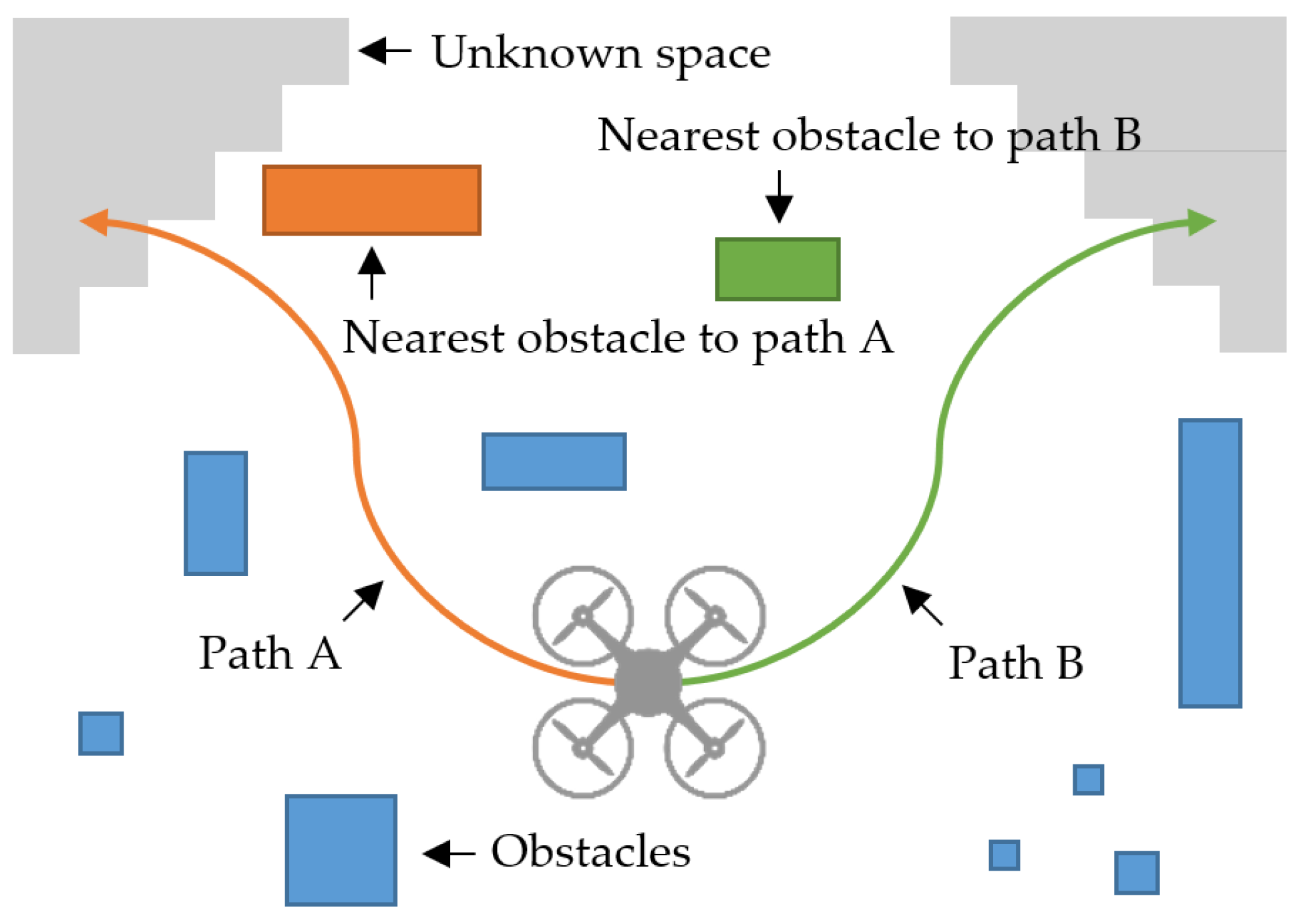

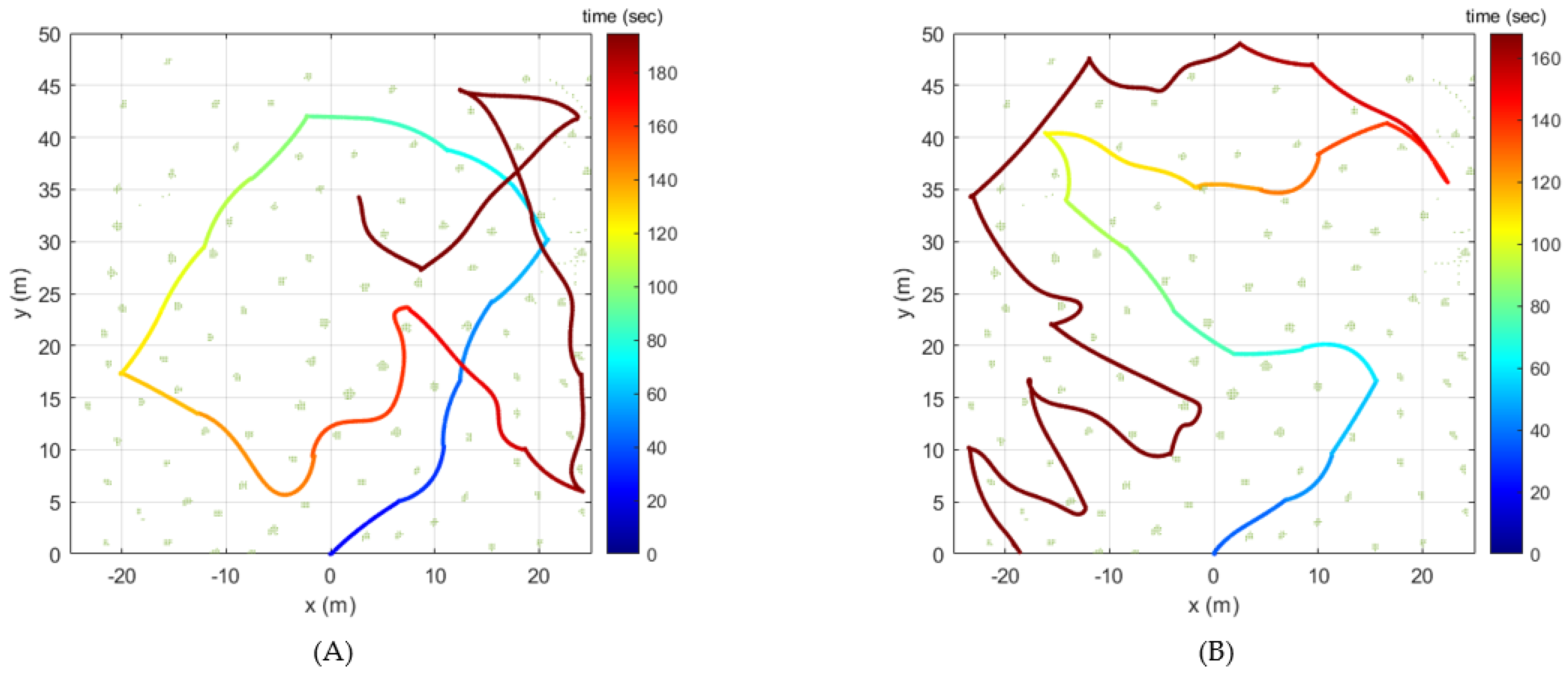
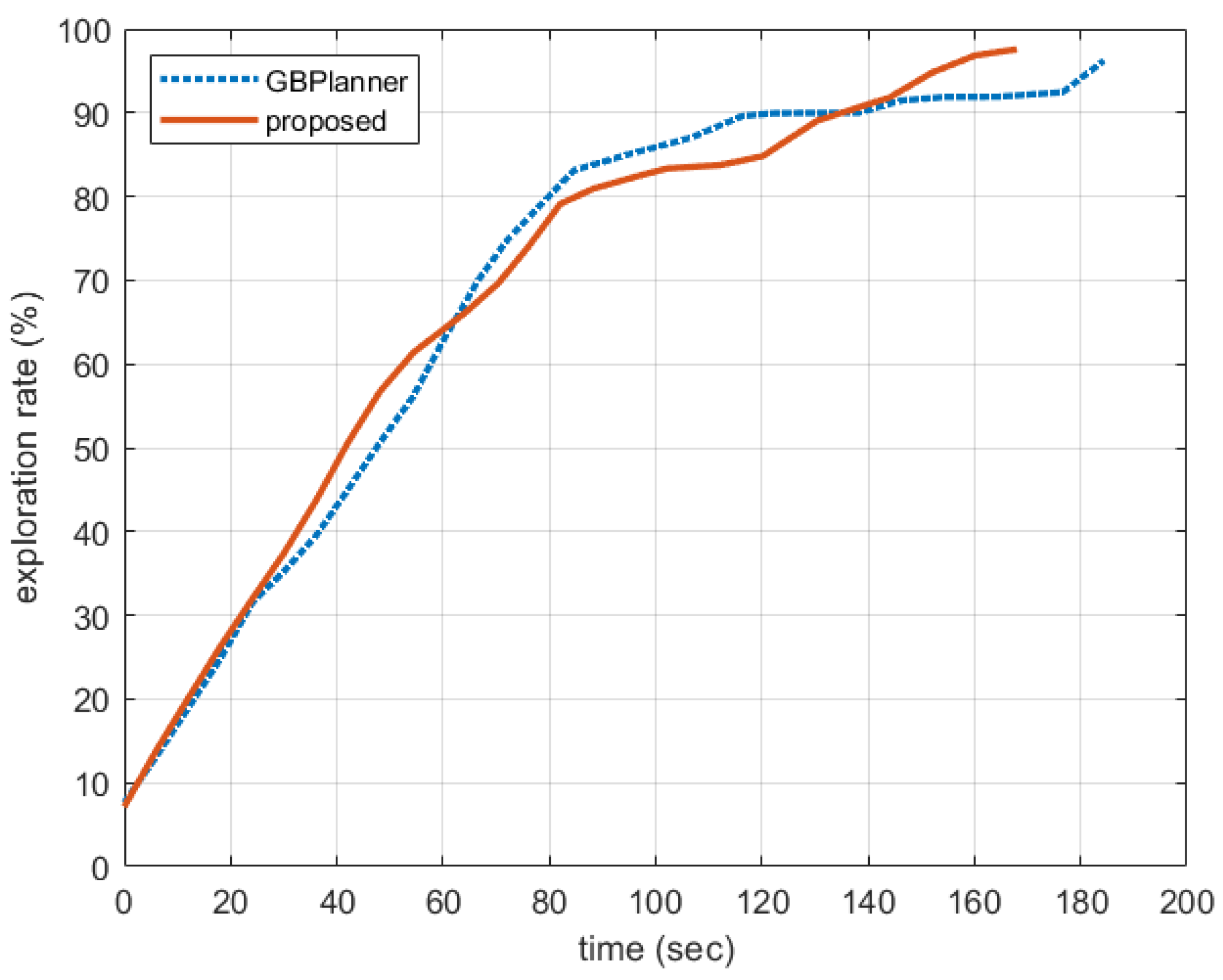
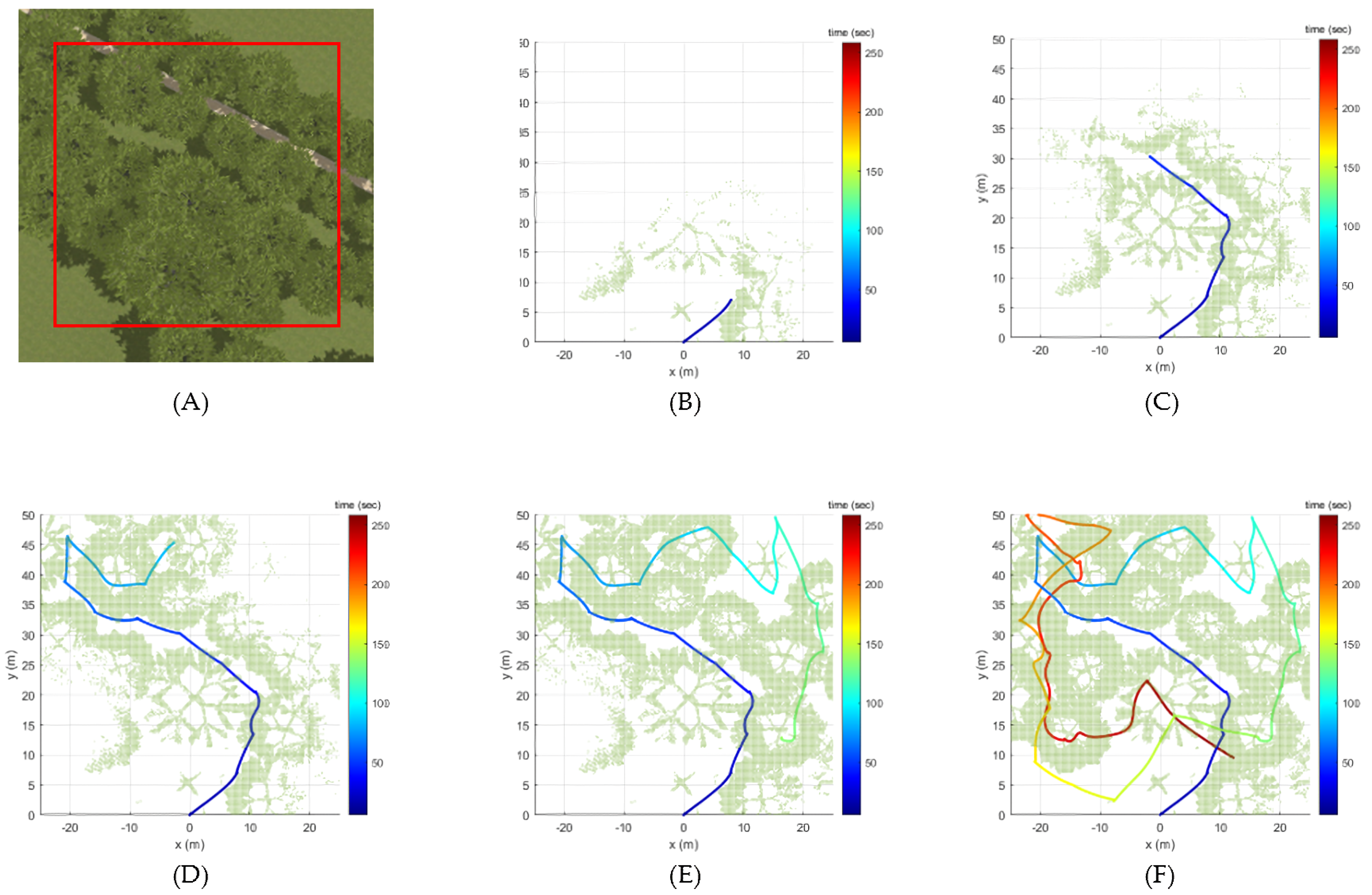



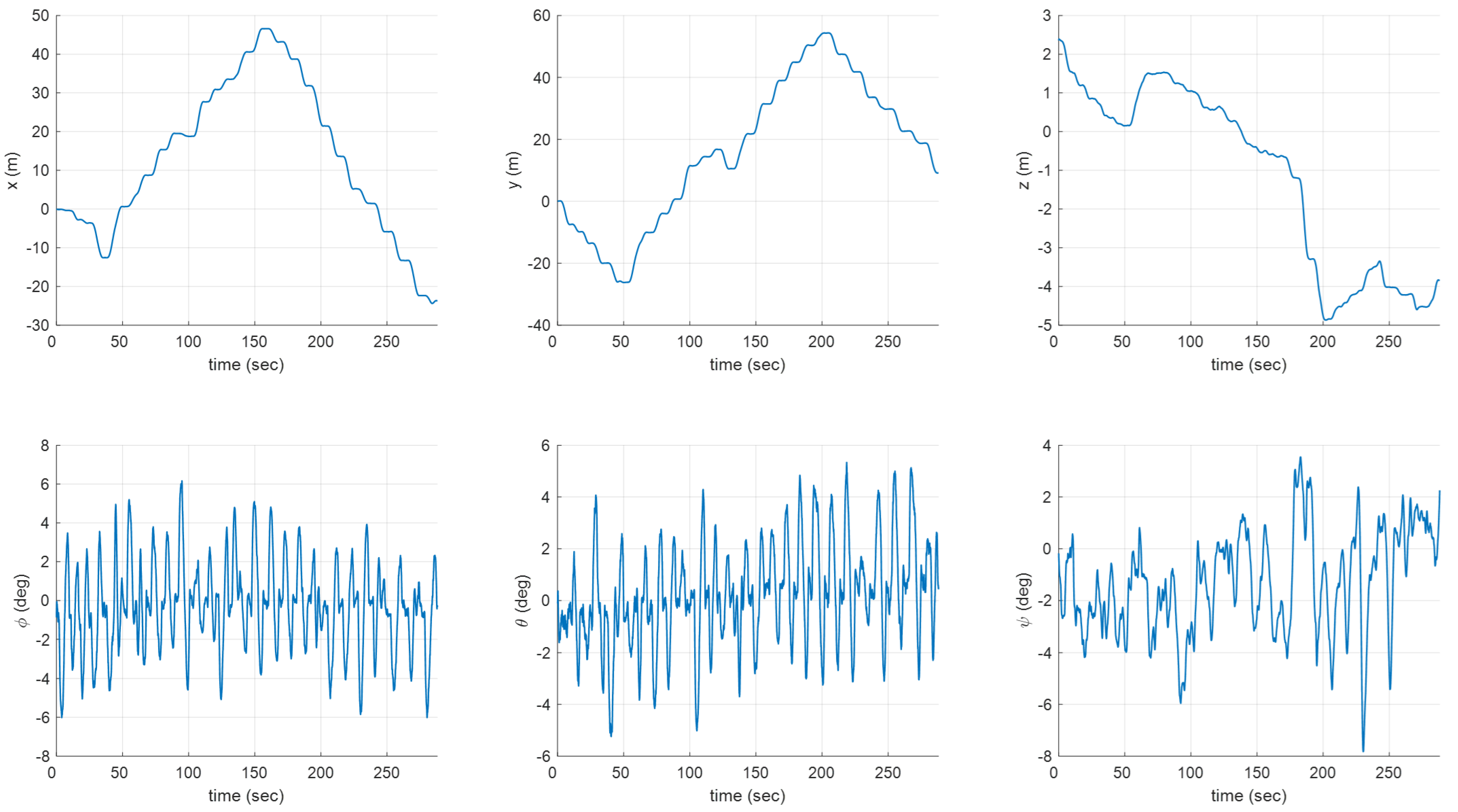
| Tree density | GBPlanner | ||
| Flight time (s) | Flight distance (m) | Nearest obstacle distance (m) | |
| 0.1 | 175.15 ± 57.08 | 287.60 ± 38.19 | 1.76 ± 0.69 |
| 0.2 | 174.97 ± 36.43 | 282.99 ± 44.54 | 1.40 ± 0.55 |
| 0.3 | 180.94 ± 37.75 | 277.03 ± 42.12 | 1.22 ± 0.44 |
| 0.4 | 186.82 ± 29.94 | 282.36 ± 52.12 | 1.12 ± 0.38 |
| Tree density | Proposed | ||
| Flight time (s) | Flight distance (m) | Nearest obstacle distance (m) | |
| 0.1 | 166.88 ± 23.53 | 271.10 ± 42.13 | 1.82 ± 0.70 |
| 0.2 | 171.17 ± 23.40 | 269.47 ± 42.50 | 1.46 ± 0.59 |
| 0.3 | 172.47 ± 21.87 | 267.55 ± 39.99 | 1.26 ± 0.48 |
| 0.4 | 173.81 ± 20.33 | 267.60 ± 40.26 | 1.19 ± 0.41 |
| Quadrotor | Frame | DIY |
| Motor | F100 KV1100 | |
| ESC | F55A PRO II | |
| Propeller | 7043 | |
| Battery | LiPo 6C 6300 mAh | |
| Sensors | 3D LiDAR | Ouster OS0 |
| AHRS | Microstrain 3DM-CV7 | |
| Computers | Flight controller | Pixhawk 6C Mini |
| Mission computer | Jetson Orin NX |
Disclaimer/Publisher’s Note: The statements, opinions and data contained in all publications are solely those of the individual author(s) and contributor(s) and not of MDPI and/or the editor(s). MDPI and/or the editor(s) disclaim responsibility for any injury to people or property resulting from any ideas, methods, instructions or products referred to in the content. |
© 2024 by the authors. Licensee MDPI, Basel, Switzerland. This article is an open access article distributed under the terms and conditions of the Creative Commons Attribution (CC BY) license (https://creativecommons.org/licenses/by/4.0/).
Share and Cite
Hong, Y.; Kim, S.; Kwon, Y.; Choi, S.; Cha, J. Safe and Efficient Exploration Path Planning for Unmanned Aerial Vehicle in Forest Environments. Aerospace 2024, 11, 598. https://doi.org/10.3390/aerospace11070598
Hong Y, Kim S, Kwon Y, Choi S, Cha J. Safe and Efficient Exploration Path Planning for Unmanned Aerial Vehicle in Forest Environments. Aerospace. 2024; 11(7):598. https://doi.org/10.3390/aerospace11070598
Chicago/Turabian StyleHong, Youkyung, Suseong Kim, Youngsun Kwon, Sanghyouk Choi, and Jihun Cha. 2024. "Safe and Efficient Exploration Path Planning for Unmanned Aerial Vehicle in Forest Environments" Aerospace 11, no. 7: 598. https://doi.org/10.3390/aerospace11070598
APA StyleHong, Y., Kim, S., Kwon, Y., Choi, S., & Cha, J. (2024). Safe and Efficient Exploration Path Planning for Unmanned Aerial Vehicle in Forest Environments. Aerospace, 11(7), 598. https://doi.org/10.3390/aerospace11070598






